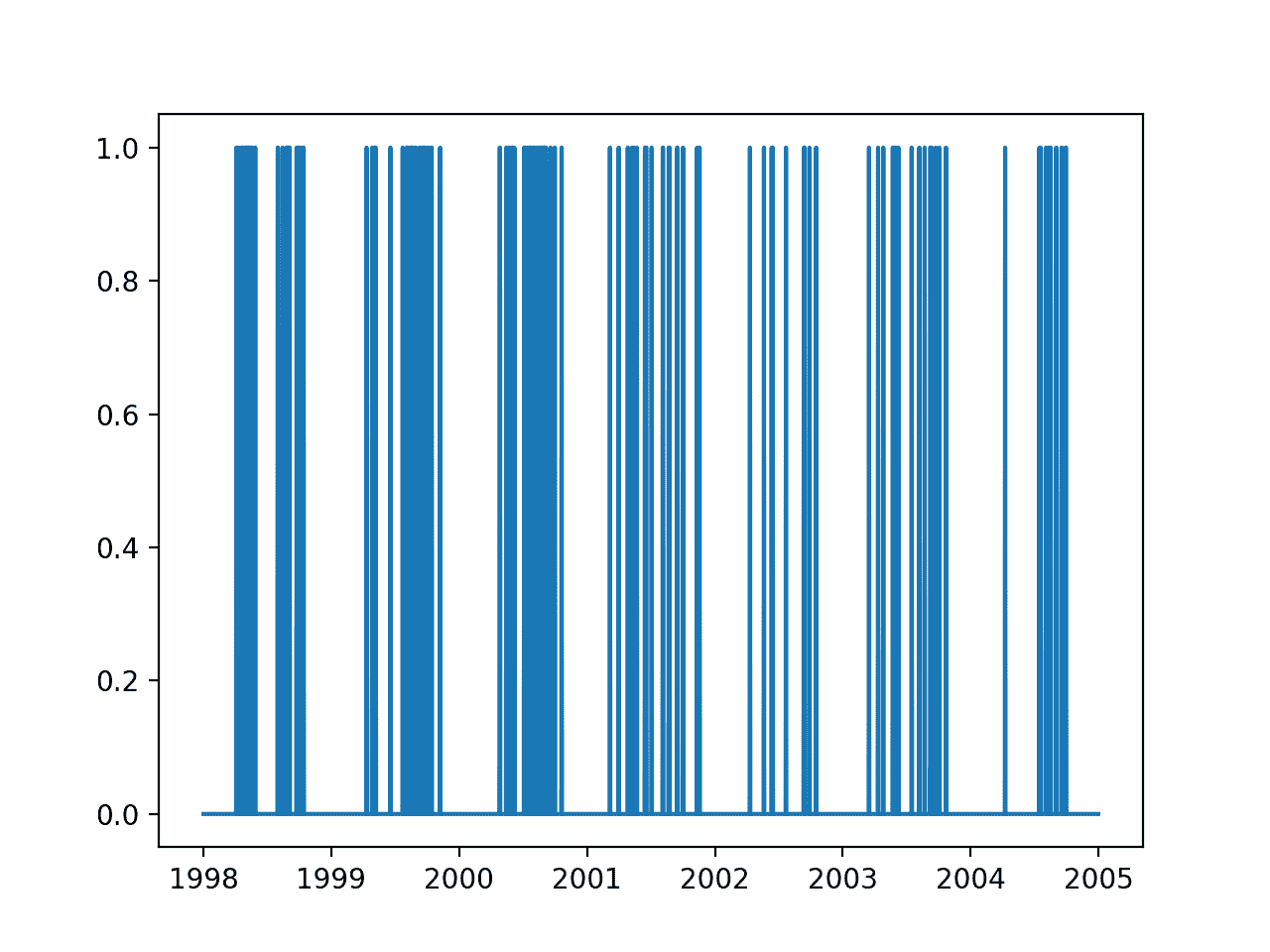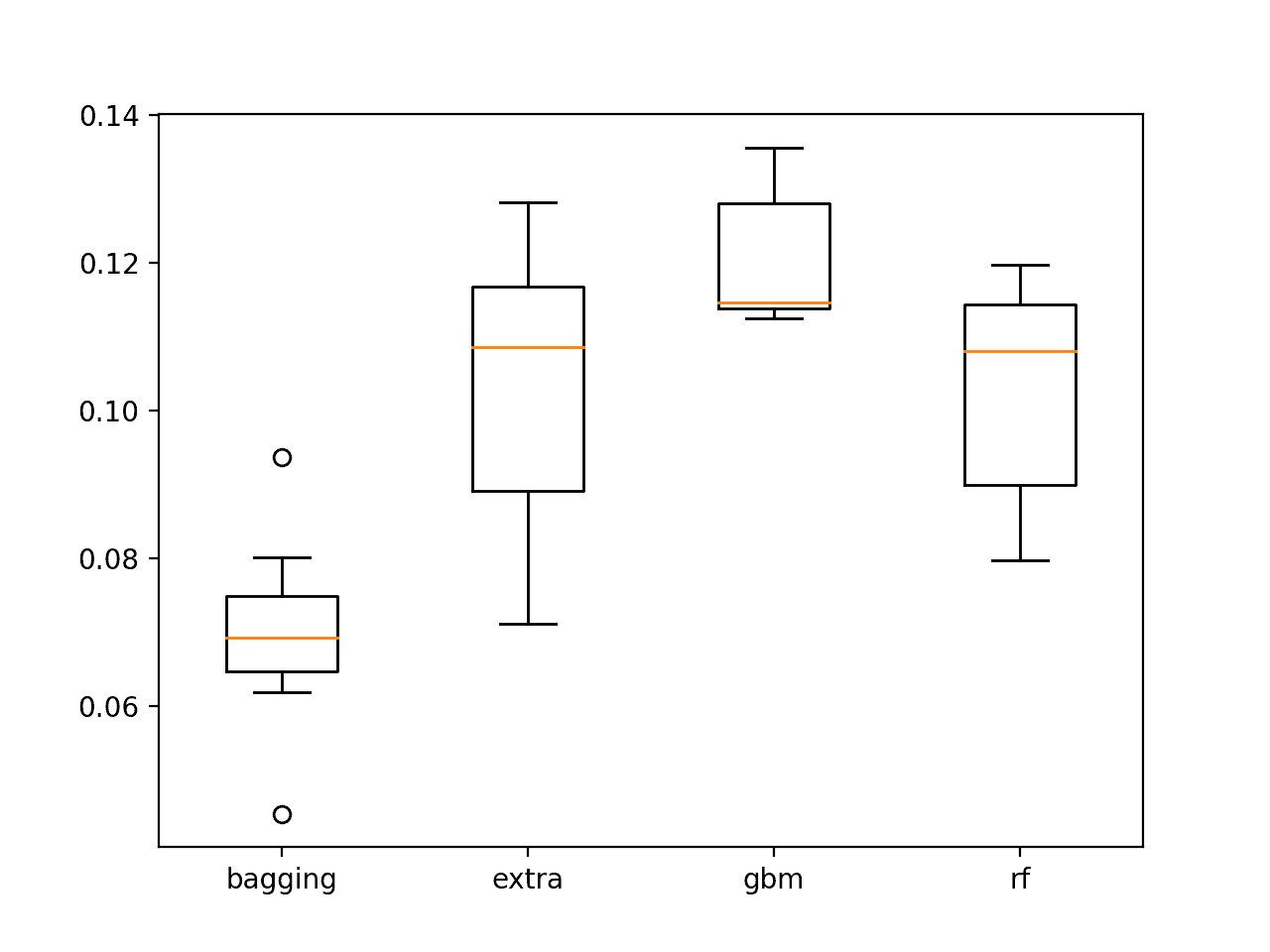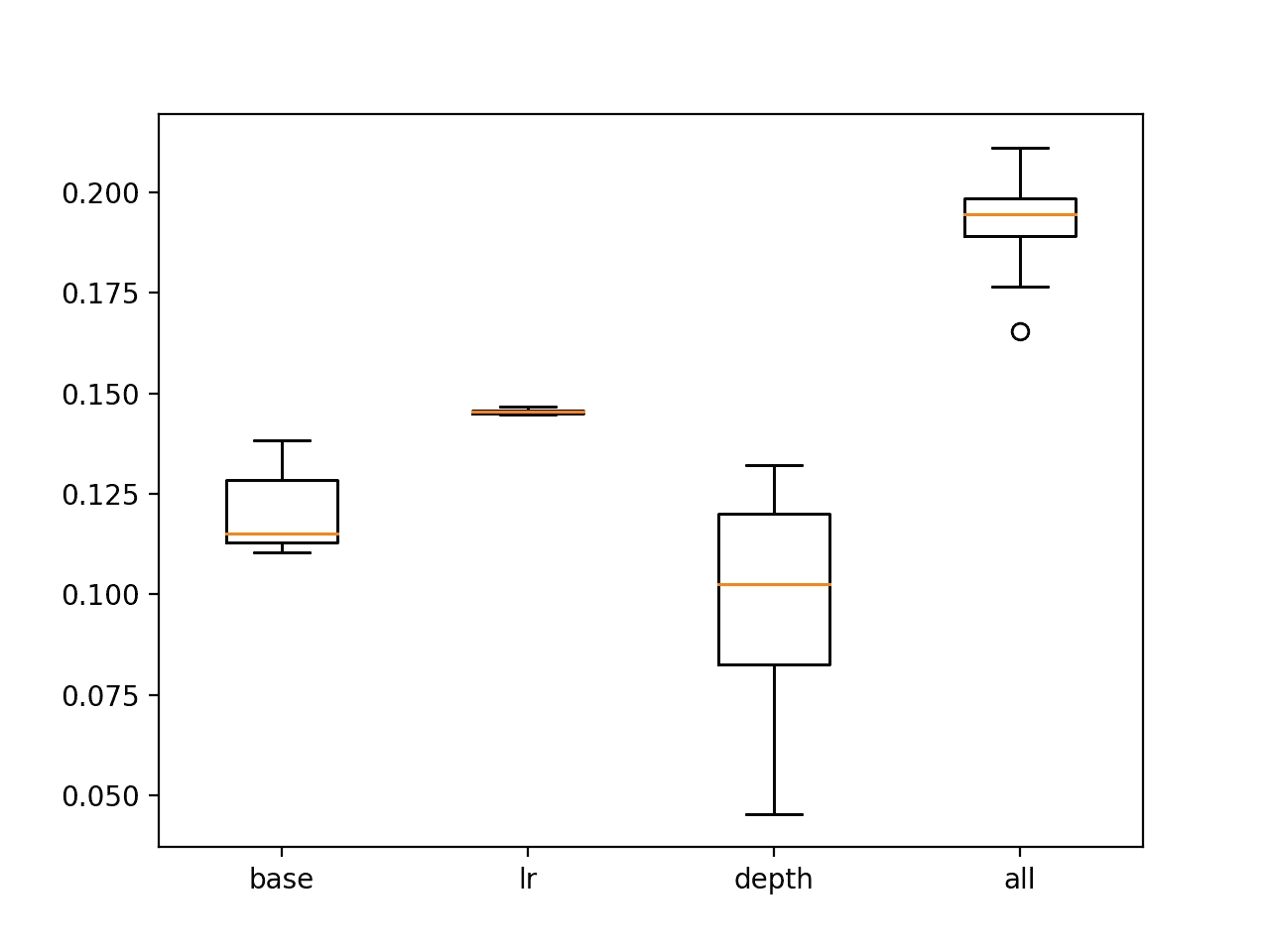# 如何建立預測大氣污染日的概率預測模型
> 原文: [https://machinelearningmastery.com/how-to-develop-a-probabilistic-forecasting-model-to-predict-air-pollution-days/](https://machinelearningmastery.com/how-to-develop-a-probabilistic-forecasting-model-to-predict-air-pollution-days/)
空氣污染的特點是地面臭氧濃度。
根據風速和溫度等氣象測量結果,可以預測明天地面臭氧是否會達到足夠高的水平,以發布公共空氣污染預警。
這是用于時間序列分類數據集的標準機器學習數據集的基礎,簡稱為“_ 臭氧預測問題 _”。該數據集描述了休斯頓地區七年來的氣象觀測以及臭氧水平是否高于臨界空氣污染水平。
在本教程中,您將了解如何探索這些數據并開發概率預測模型,以預測德克薩斯州休斯頓的空氣污染。
完成本教程后,您將了解:
* 如何加載和準備臭氧日標準機器學習預測建模問題。
* 如何開發一個樸素的預測模型,并使用 Brier 技能分數評估預測。
* 如何使用決策樹集合開發技巧模型,并通過成功模型的超參數調整進一步提高技能。
讓我們開始吧。

如何建立預測空氣污染日的概率預測模型
照片由 [paramita](https://www.flickr.com/photos/parramitta/6715213551/) ,保留一些權利。
## 教程概述
本教程分為五個部分;他們是:
1. 臭氧預測問題
2. 加載和檢查數據
3. 樸素預測模型
4. 集合樹預測模型
5. 調整梯度提升
## 臭氧預測問題
空氣污染的特征在于地面臭氧的高度測量,通常被稱為“[不良臭氧](https://en.wikipedia.org/wiki/Tropospheric_ozone)”,以區??別于高層大氣中的臭氧。
臭氧預測問題是時間序列分類預測問題,其涉及預測第二天是否將是高空氣污染日(臭氧日)。氣象組織可以利用臭氧日的預測來警告公眾,使他們能夠采取預防措施。
該數據集最初由 Kun Zhang 等人研究。他們在 2006 年的論文“[預測偏差隨機臭氧天數:分析和解決方案](https://ieeexplore.ieee.org/abstract/document/4053100/)”,然后在他們的后續報告中再次提到“[預測偏差隨機臭氧天:分析,解決方案及其他](https://link.springer.com/article/10.1007/s10115-007-0095-1) “。
這是一個具有挑戰性的問題,因為高臭氧水平的物理機制是(或沒有)被完全理解,這意味著預測不能像其他氣象預報一樣基于物理模擬,如溫度和降雨量。
該數據集被用作開發預測模型的基礎,該模型使用一系列可能與預測臭氧水平相關或可能不相關的變量,此外還有少數已知與所涉及的實際化學過程相關的變量。
> 然而,環境科學家普遍認為,目前從未探索過的大量其他特征在建立高度精確的臭氧預測模型中非常有用。然而,鮮為人知的是這些特征究竟是什么以及它們如何在臭氧形成中實際相互作用。 [...]今天的環境科學都沒有知道如何使用它們。這為數據挖掘提供了絕佳的機會
- [預測偏差隨機臭氧天數:分析和解決方案](https://ieeexplore.ieee.org/abstract/document/4053100/),2006 年。
在隨后的一天預測高水平的地面臭氧是一個具有挑戰性的問題,已知其具有隨機性。這意味著預計會出現預測錯誤。因此,希望概率地對預測問題進行建模并預測臭氧日的概率,或者在前一天或幾天給出觀察結果。
該數據集包含七年的每日氣象變量觀測值(1998-2004 或 2,536 天)以及是否有臭氧日,在美國德克薩斯州的休斯頓,加爾維斯頓和布拉佐里亞地區進行。
每天共觀察到 72 個變量,其中許多被認為與預測問題相關,其中 10 個已根據物理學確認為相關。
> [...]這 72 個特征中只有大約 10 個特征已經被環境科學家證實是有用和相關的,并且關于其他 60 個特征的相關性,既沒有經驗也沒有理論信息。然而,空氣質量控制科學家長期以來一直在猜測這些特征中的一些可能是有用的,但是無法發展理論或使用模擬來證明其相關性。
- [預測偏差隨機臭氧天數:分析和解決方案](https://ieeexplore.ieee.org/abstract/document/4053100/),2006 年。
有 24 個變量跟蹤每小時風速,另外 24 個變量跟蹤一天中每小時的溫度。數據集的兩個版本可用于度量的不同平均周期,特別是 1 小時和 8 小時。
似乎缺少并可能有用的是每天觀察到的臭氧,而不是二氧化硫臭氧日/非臭氧日。參數模型中使用的其他度量也不可用。
有趣的是,基于“[開發臭氧預測計劃指南](https://nepis.epa.gov/Exe/ZyPURL.cgi?Dockey=2000D6KP.TXT)”,1999 年 EPA 指南中的描述,使用參數臭氧預測模型作為基線。該文件還描述了驗證臭氧預報系統的標準方法。
總之,這是一個具有挑戰性的預測問題,因為:
* 存在大量變量,其重要性通常是未知的。
* 輸入變量及其相互關系可能會隨時間而變化。
* 對于需要處理的許多變量缺少觀察結果。
* 非臭氧日(非事件)遠遠超過臭氧日(事件),使得這些類別高度不平衡。
## 加載和檢查數據
該數據集可從 UCI 機器學習庫獲得。
* [臭氧水平檢測數據集](https://archive.ics.uci.edu/ml/datasets/ozone+level+detection)
我們只會查看本教程中的 8 小時數據。下載“ _eighthr.data_ ”并將其放在當前的工作目錄中。
檢查數據文件,我們可以看到不同尺度的觀察結果。
```py
1/1/1998,0.8,1.8,2.4,2.1,2,2.1,1.5,1.7,1.9,2.3,3.7,5.5,5.1,5.4,5.4,4.7,4.3,3.5,3.5,2.9,3.2,3.2,2.8,2.6,5.5,3.1,5.2,6.1,6.1,6.1,6.1,5.6,5.2,5.4,7.2,10.6,14.5,17.2,18.3,18.9,19.1,18.9,18.3,17.3,16.8,16.1,15.4,14.9,14.8,15,19.1,12.5,6.7,0.11,3.83,0.14,1612,-2.3,0.3,7.18,0.12,3178.5,-15.5,0.15,10.67,-1.56,5795,-12.1,17.9,10330,-55,0,0.
1/2/1998,2.8,3.2,3.3,2.7,3.3,3.2,2.9,2.8,3.1,3.4,4.2,4.5,4.5,4.3,5.5,5.1,3.8,3,2.6,3,2.2,2.3,2.5,2.8,5.5,3.4,15.1,15.3,15.6,15.6,15.9,16.2,16.2,16.2,16.6,17.8,19.4,20.6,21.2,21.8,22.4,22.1,20.8,19.1,18.1,17.2,16.5,16.1,16,16.2,22.4,17.8,9,0.25,-0.41,9.53,1594.5,-2.2,0.96,8.24,7.3,3172,-14.5,0.48,8.39,3.84,5805,14.05,29,10275,-55,0,0.
1/3/1998,2.9,2.8,2.6,2.1,2.2,2.5,2.5,2.7,2.2,2.5,3.1,4,4.4,4.6,5.6,5.4,5.2,4.4,3.5,2.7,2.9,3.9,4.1,4.6,5.6,3.5,16.6,16.7,16.7,16.8,16.8,16.8,16.9,16.9,17.1,17.6,19.1,21.3,21.8,22,22.1,22.2,21.3,19.8,18.6,18,18,18.2,18.3,18.4,22.2,18.7,9,0.56,0.89,10.17,1568.5,0.9,0.54,3.8,4.42,3160,-15.9,0.6,6.94,9.8,5790,17.9,41.3,10235,-40,0,0.
...
```
瀏覽文件,例如到 2003 年初,我們可以看到缺少的觀察值標有“?”值。
```py
...
12/29/2002,?,?,?,?,?,?,?,?,?,?,?,?,?,?,?,?,?,?,?,?,?,?,?,?,?,?,?,?,?,?,?,?,?,?,?,?,?,?,?,?,?,?,?,?,?,?,?,?,?,?,?,?,11.7,0.09,5.59,3.79,1578,5.7,0.04,1.8,4.8,3181.5,-13,0.02,0.38,2.78,5835,-31.1,18.9,10250,-25,0.03,0.
12/30/2002,?,?,?,?,?,?,?,?,?,?,?,?,?,?,?,?,?,?,?,?,?,?,?,?,?,?,?,?,?,?,?,?,?,?,?,?,?,?,?,?,?,?,?,?,?,?,?,?,?,?,?,?,10.3,0.43,3.88,9.21,1525.5,1.8,0.87,9.17,9.96,3123,-11.3,0.03,11.23,10.79,5780,17,30.2,10175,-75,1.68,0.
12/31/2002,?,?,?,?,?,?,?,?,?,?,?,?,?,?,?,?,?,?,?,?,?,?,?,?,?,?,?,?,?,?,?,?,?,?,?,?,?,?,?,?,?,?,?,?,?,?,?,?,?,?,?,?,8.5,0.96,6.05,11.18,1433,-0.85,0.91,7.02,6.63,3014,-16.2,0.05,15.77,24.38,5625,31.15,48.75,10075,-100,0.05,0.
1/1/2003,?,?,?,?,?,?,?,?,?,?,?,?,?,?,?,?,?,?,?,?,?,?,?,?,?,?,7.2,5.7,4.5,4,3.6,3.3,3.1,3.2,6.7,11.1,13.8,15.8,17.2,18.6,20,21.1,21.5,20.4,19.1,17.8,17.4,16.9,16.6,14.9,21.5,12.6,6.4,0.6,12.91,-10.17,1421.5,1.95,0.55,11.97,-7.78,3006.5,-14.1,0.44,20.42,-13.31,5640,2.9,30.5,10095,35,0,0.
...
```
首先,我們可以使用 [read_csv()函數](https://pandas.pydata.org/pandas-docs/stable/generated/pandas.read_csv.html)將數據作為 Pandas DataFrame 加載。沒有數據頭,我們可以解析第一列中的日期并將它們用作索引;下面列出了完整的示例。
```py
# load and summarize
from pandas import read_csv
from matplotlib import pyplot
# load dataset
data = read_csv('eighthr.data', header=None, index_col=0, parse_dates=True, squeeze=True)
print(data.shape)
# summarize class counts
counts = data.groupby(73).size()
for i in range(len(counts)):
percent = counts[i] / data.shape[0] * 100
print('Class=%d, total=%d, percentage=%.3f' % (i, counts[i], percent))
```
運行該示例確認有 2,534 天的數據和 73 個變量。
我們還可以看到階級不平衡的性質,其中 93%以上的日子是非臭氧日,約 6%是臭氧日。
```py
(2534, 73)
Class=0, total=2374, percentage=93.686
Class=1, total=160, percentage=6.314
```
我們還可以在七年內創建輸出變量的線圖,以了解臭氧天數是否發生在一年中的任何特定時間。
```py
# load and plot output variable
from pandas import read_csv
from matplotlib import pyplot
# load dataset
data = read_csv('eighthr.data', header=None, index_col=0, parse_dates=True, squeeze=True)
# plot the output variable
pyplot.plot(data.index, data.values[:,-1])
pyplot.show()
```
運行該示例將創建七年內輸出變量的線圖。
我們可以看到,每年中期都有臭氧天集群:北半球夏季或溫暖的月份。

輸出變量的線圖超過 7 年
通過簡要回顧一下觀察結果,我們可以得到一些關于如何準備數據的想法:
* 缺少數據需要處理。
* 最簡單的框架是根據今天的觀察結果預測明天的臭氧日。
* 溫度可能與季節或一年中的時間相關,可能是一個有用的預測指標。
* 數據變量可能需要縮放(標準化),甚至可能需要標準化,具體取決于所選的算法。
* 預測概率將提供比預測類值更多的細微差別。
* 也許我們可以使用五年(約 72%)來訓練模型并在剩余的兩年內測試它(約 28%)
我們可以執行一些最小的數據準備。
下面的示例加載數據集,用 0.0 替換缺失的觀測值,將數據構建為監督學習問題(明天根據今天的觀察結果預測臭氧),并根據大量天數將數據分成訓練和測試集。兩年。
您可以探索替換缺失值的替代方法,例如輸入平均值。此外,2004 年是一個閏年,因此將數據分成訓練和測試集并不是一個干凈的 5 - 2 年分裂,但是對于本教程來說足夠接近。
```py
# load and prepare
from pandas import read_csv
from matplotlib import pyplot
from numpy import array
from numpy import hstack
from numpy import savetxt
# load dataset
data = read_csv('eighthr.data', header=None, index_col=0, parse_dates=True, squeeze=True)
values = data.values
# replace missing observations with 0
values[values=='?'] = 0.0
# frame as supervised learning
supervised = list()
for i in range(len(values) - 1):
X, y = values[i, :-1], values[i + 1, -1]
row = hstack((X,y))
supervised.append(row)
supervised = array(supervised)
# split into train-test
split = 365 * 2
train, test = supervised[:-split,:], supervised[-split:,:]
train, test = train.astype('float32'), test.astype('float32')
print(train.shape, test.shape)
# save prepared datasets
savetxt('train.csv', train, delimiter=',')
savetxt('test.csv', test, delimiter=',')
```
運行該示例將訓練和測試集保存為 CSV 文件,并匯總兩個數據集的形狀。
```py
(1803, 73) (730, 73)
```
## 樸素預測模型
一個樸素的模型可以預測每天臭氧日的概率。
這是一種樸素的方法,因為它不使用除事件基本速率之外的任何信息。在氣象預報的驗證中,這被稱為氣候預報。
我們可以從訓練數據集中估計臭氧日的概率,如下所示。
```py
# load datasets
train = loadtxt('train.csv', delimiter=',')
test = loadtxt('test.csv', delimiter=',')
# estimate naive probabilistic forecast
naive = sum(train[:,-1]) / train.shape[0]
```
然后,我們可以預測測試數據集中每天臭氧日的初始概率。
```py
# forecast the test dataset
yhat = [naive for _ in range(len(test))]
```
一旦我們有了預測,我們就可以對其進行評估。
評估概率預測的有用措施是 [Brier 評分](https://en.wikipedia.org/wiki/Brier_score)。該分數可以被認為是來自預期概率(0%或 1%)的預測概率(例如 5%)的均方誤差。它是測試數據集中每天發生的錯誤的平均值。
我們感興趣的是最小化 Brier 分數,較小的值更好,例如更小的錯誤。
我們可以使用 scikit-learn 庫中的 [brier_score_loss()函數](http://scikit-learn.org/stable/modules/generated/sklearn.metrics.brier_score_loss.html)來評估預測的 Brier 分數。
```py
# evaluate forecast
testy = test[:, -1]
bs = brier_score_loss(testy, yhat)
print('Brier Score: %.6f' % bs)
```
對于熟練的模型,它必須具有比樸素預測的分數更好的分數。
我們可以通過計算基于樸素預測標準化 Brier 分數(BS)的 Brier 技能分數(BSS)來證明這一點。
我們預計樸素預報的計算 BSS 將為 0.0。展望未來,我們有興趣最大化此分數,例如較大的 BSS 分數更好。
```py
# calculate brier skill score
bs_ref = bs
bss = (bs - bs_ref) / (0 - bs_ref)
print('Brier Skill Score: %.6f' % bss)
```
下面列出了幼稚預測的完整示例。
```py
# naive prediction method
from sklearn.metrics import brier_score_loss
from numpy import loadtxt
# load datasets
train = loadtxt('train.csv', delimiter=',')
test = loadtxt('test.csv', delimiter=',')
# estimate naive probabilistic forecast
naive = sum(train[:,-1]) / train.shape[0]
print(naive)
# forecast the test dataset
yhat = [naive for _ in range(len(test))]
# evaluate forecast
testy = test[:, -1]
bs = brier_score_loss(testy, yhat)
print('Brier Score: %.6f' % bs)
# calculate brier skill score
bs_ref = bs
bss = (bs - bs_ref) / (0 - bs_ref)
print('Brier Skill Score: %.6f' % bss)
```
運行這個例子,我們可以看到臭氧日的樸素概率甚至約為 7.2%。
使用基本費率作為預測會導致 Brier 技能為 0.039,預期 Brier 技能得分為 0.0(忽略該符號)。
```py
0.07265668330560178
Brier Score: 0.039232
Brier Skill Score: -0.000000
```
我們現在準備探索一些機器學習方法,看看我們是否可以為此預測添加技能。
請注意,原始論文使用精確度和直接召回來評估方法的技巧,這是一種用于方法之間直接比較的令人驚訝的方法。
也許您可以探索的替代措施是 ROC 曲線下的面積(ROC AUC)。繪制最終模型的 ROC 曲線將允許模型的操作者選擇閾值,該閾值提供真正的正(命中)和誤報(誤報)速率之間的期望平衡水平。
## 集合樹預測模型
原始論文報告了袋裝決策樹的一些成功。
> 盡管我們對歸納學習器的選擇是非窮盡的,但本文已經表明,歸納學習可以作為臭氧水平預測的一種選擇方法,而基于集合的概率樹提供比現有方法更好的預測(更高的召回率和精確度)。
- [預測偏差隨機臭氧天數:分析和解決方案](https://ieeexplore.ieee.org/abstract/document/4053100/),2006 年。
出于以下幾個原因,這并不奇怪:
* 袋裝決策樹不需要任何數據縮放。
* Bagged 決策樹自動執行一種功能部分,忽略不相關的功能。
* 袋裝決策樹預測合理校準的概率(例如,與 SVM 不同)。
這表明在測試機器學習算法時,這是一個很好的起點。
我們可以通過現場檢查 scikit-learn 庫中標準集合樹方法樣本的表現來快速入門,其默認配置和樹數設置為 100。
具體來說,方法:
* 袋裝決策樹(BaggingClassifier)
* 額外樹木(ExtraTreesClassifier)
* 隨機梯度提升(GradientBoostingClassifier)
* 隨機森林(RandomForestClassifier)
首先,我們必須將訓練和測試數據集分成輸入(X)和輸出(y)組件,以便我們可以擬合 sklearn 模型。
```py
# load datasets
train = loadtxt('train.csv', delimiter=',')
test = loadtxt('test.csv', delimiter=',')
# split into inputs/outputs
trainX, trainy, testX, testy = train[:,:-1],train[:,-1],test[:,:-1],test[:,-1]
```
我們還需要 Brier 分數進行樸素的預測,以便我們能夠正確計算新模型的 Brier 技能分數。
```py
# estimate naive probabilistic forecast
naive = sum(train[:,-1]) / train.shape[0]
# forecast the test dataset
yhat = [naive for _ in range(len(test))]
# calculate naive bs
bs_ref = brier_score_loss(testy, yhat)
```
我們可以一般地評估單個 scikit-learn 模型的技能。
下面定義名為 _evaluate_once()_ 的函數,該函數適合并評估給定的已定義和配置的 scikit-learn 模型并返回 Brier 技能分數(BSS)。
```py
# evaluate a sklearn model
def evaluate_once(bs_ref, template, trainX, trainy, testX, testy):
# fit model
model = clone(template)
model.fit(trainX, trainy)
# predict probabilities for 0 and 1
probs = model.predict_proba(testX)
# keep the probabilities for class=1 only
yhat = probs[:, 1]
# calculate brier score
bs = brier_score_loss(testy, yhat)
# calculate brier skill score
bss = (bs - bs_ref) / (0 - bs_ref)
return bss
```
集合樹是一種隨機機器學習方法。
這意味著當相同模型的相同配置在相同數據上訓練時,它們將做出不同的預測。為了糾正這個問題,我們可以多次評估給定模型,例如 10 次,并計算每次運行的平均技能。
下面的函數將評估給定模型 10 次,打印平均 BSS 分數,并返回分數的總體用于分析。
```py
# evaluate an sklearn model n times
def evaluate(bs_ref, model, trainX, trainy, testX, testy, n=10):
scores = [evaluate_once(bs_ref, model, trainX, trainy, testX, testy) for _ in range(n)]
print('>%s, bss=%.6f' % (type(model), mean(scores)))
return scores
```
我們現在準備評估一套集合決策樹算法。
下面列出了完整的示例。
```py
# evaluate ensemble tree methods
from numpy import loadtxt
from numpy import mean
from matplotlib import pyplot
from sklearn.base import clone
from sklearn.metrics import brier_score_loss
from sklearn.ensemble import BaggingClassifier
from sklearn.ensemble import ExtraTreesClassifier
from sklearn.ensemble import GradientBoostingClassifier
from sklearn.ensemble import RandomForestClassifier
# evaluate a sklearn model
def evaluate_once(bs_ref, template, trainX, trainy, testX, testy):
# fit model
model = clone(template)
model.fit(trainX, trainy)
# predict probabilities for 0 and 1
probs = model.predict_proba(testX)
# keep the probabilities for class=1 only
yhat = probs[:, 1]
# calculate brier score
bs = brier_score_loss(testy, yhat)
# calculate brier skill score
bss = (bs - bs_ref) / (0 - bs_ref)
return bss
# evaluate an sklearn model n times
def evaluate(bs_ref, model, trainX, trainy, testX, testy, n=10):
scores = [evaluate_once(bs_ref, model, trainX, trainy, testX, testy) for _ in range(n)]
print('>%s, bss=%.6f' % (type(model), mean(scores)))
return scores
# load datasets
train = loadtxt('train.csv', delimiter=',')
test = loadtxt('test.csv', delimiter=',')
# split into inputs/outputs
trainX, trainy, testX, testy = train[:,:-1],train[:,-1],test[:,:-1],test[:,-1]
# estimate naive probabilistic forecast
naive = sum(train[:,-1]) / train.shape[0]
# forecast the test dataset
yhat = [naive for _ in range(len(test))]
# calculate naive bs
bs_ref = brier_score_loss(testy, yhat)
# evaluate a suite of ensemble tree methods
scores, names = list(), list()
n_trees=100
# bagging
model = BaggingClassifier(n_estimators=n_trees)
avg_bss = evaluate(bs_ref, model, trainX, trainy, testX, testy)
scores.append(avg_bss)
names.append('bagging')
# extra
model = ExtraTreesClassifier(n_estimators=n_trees)
avg_bss = evaluate(bs_ref, model, trainX, trainy, testX, testy)
scores.append(avg_bss)
names.append('extra')
# gbm
model = GradientBoostingClassifier(n_estimators=n_trees)
avg_bss = evaluate(bs_ref, model, trainX, trainy, testX, testy)
scores.append(avg_bss)
names.append('gbm')
# rf
model = RandomForestClassifier(n_estimators=n_trees)
avg_bss = evaluate(bs_ref, model, trainX, trainy, testX, testy)
scores.append(avg_bss)
names.append('rf')
# plot results
pyplot.boxplot(scores, labels=names)
pyplot.show()
```
運行該示例總結了 10 次運行中平均每個模型的平均 BSS。
鑒于算法的隨機性,您的具體結果可能會有所不同,但趨勢應該相同。
從平均 BSS 分數來看,它表明額外的樹木,隨機梯度增強和隨機森林模型是最熟練的。
```py
><class 'sklearn.ensemble.bagging.BaggingClassifier'>, bss=0.069762
><class 'sklearn.ensemble.forest.ExtraTreesClassifier'>, bss=0.103291
><class 'sklearn.ensemble.gradient_boosting.GradientBoostingClassifier'>, bss=0.119803
><class 'sklearn.ensemble.forest.RandomForestClassifier'>, bss=0.102736
```
繪制每個模型的分數的盒子和須狀圖。
他們所有跑步的所有模型都顯示出樸素預測的技巧(正分數),這是非常令人鼓舞的。
額外樹木,隨機梯度提升和隨機森林的 BSS 分數的分布看起來都令人鼓舞。

測試集上的集合決策樹 BSS 分數的框和胡須圖
## 調整梯度提升
鑒于隨機梯度增強看起來很有希望,有必要探討是否可以通過某些[參數調整](http://scikit-learn.org/stable/modules/generated/sklearn.ensemble.GradientBoostingClassifier.html)進一步提升模型的表現。
有許多參數可以調整模型,但調整模型的一些好的啟發式方法包括:
* 降低學習率( _learning_rate_ ),同時增加決策樹的數量( _n_estimators_ )。
* 增加決策樹的最大深度( _max_depth_ ),同時減少可用于擬合樹的樣本數(_ 樣本 _)。
我們可以根據這些原則檢查一些參數,而不是網格搜索值。如果您有時間和計算資源,可以自己探索這些參數的網格搜索。
我們將比較 GBM 模型的四種配置:
* **基線**:如前一節測試的那樣( _learning_rate_ = 0.1, _n_estimators_ = 100,_ 子樣本 _ = 1.0, _max_depth_ = 3)
* **lr** ,學習率較低且樹木較多( _learning_rate_ = 0.01, _n_estimators_ = 500,_ 子樣本 _ = 1.0, _max_depth_ = 3)
* **深度**,最大樹深度增加,數據集采樣量減少( _learning_rate_ = 0.1, _n_estimators_ = 100,_ 子樣本 _ = 0.7, _max_depth_ =)
* **所有**,所有修改。
下面列出了完整的示例。
```py
# tune the gbm configuration
from numpy import loadtxt
from numpy import mean
from matplotlib import pyplot
from sklearn.base import clone
from sklearn.metrics import brier_score_loss
from sklearn.ensemble import BaggingClassifier
from sklearn.ensemble import ExtraTreesClassifier
from sklearn.ensemble import GradientBoostingClassifier
from sklearn.ensemble import RandomForestClassifier
# evaluate a sklearn model
def evaluate_once(bs_ref, template, trainX, trainy, testX, testy):
# fit model
model = clone(template)
model.fit(trainX, trainy)
# predict probabilities for 0 and 1
probs = model.predict_proba(testX)
# keep the probabilities for class=1 only
yhat = probs[:, 1]
# calculate brier score
bs = brier_score_loss(testy, yhat)
# calculate brier skill score
bss = (bs - bs_ref) / (0 - bs_ref)
return bss
# evaluate an sklearn model n times
def evaluate(bs_ref, model, trainX, trainy, testX, testy, n=10):
scores = [evaluate_once(bs_ref, model, trainX, trainy, testX, testy) for _ in range(n)]
print('>%s, bss=%.6f' % (type(model), mean(scores)))
return scores
# load datasets
train = loadtxt('train.csv', delimiter=',')
test = loadtxt('test.csv', delimiter=',')
# split into inputs/outputs
trainX, trainy, testX, testy = train[:,:-1],train[:,-1],test[:,:-1],test[:,-1]
# estimate naive probabilistic forecast
naive = sum(train[:,-1]) / train.shape[0]
# forecast the test dataset
yhat = [naive for _ in range(len(test))]
# calculate naive bs
bs_ref = brier_score_loss(testy, yhat)
# evaluate a suite of ensemble tree methods
scores, names = list(), list()
# base
model = GradientBoostingClassifier(learning_rate=0.1, n_estimators=100, subsample=1.0, max_depth=3)
avg_bss = evaluate(bs_ref, model, trainX, trainy, testX, testy)
scores.append(avg_bss)
names.append('base')
# learning rate
model = GradientBoostingClassifier(learning_rate=0.01, n_estimators=500, subsample=1.0, max_depth=3)
avg_bss = evaluate(bs_ref, model, trainX, trainy, testX, testy)
scores.append(avg_bss)
names.append('lr')
# depth
model = GradientBoostingClassifier(learning_rate=0.1, n_estimators=100, subsample=0.7, max_depth=7)
avg_bss = evaluate(bs_ref, model, trainX, trainy, testX, testy)
scores.append(avg_bss)
names.append('depth')
# all
model = GradientBoostingClassifier(learning_rate=0.01, n_estimators=500, subsample=0.7, max_depth=7)
avg_bss = evaluate(bs_ref, model, trainX, trainy, testX, testy)
scores.append(avg_bss)
names.append('all')
# plot results
pyplot.boxplot(scores, labels=names)
pyplot.show()
```
運行該示例為每個配置打印 10 個運行的平均每個模型的 BSS。
結果表明,單獨學習率和樹木數量的變化引起了對默認配置的一些提升。
結果還表明,包含每個變化的“所有”配置導致最佳平均 BSS。
```py
><class 'sklearn.ensemble.gradient_boosting.GradientBoostingClassifier'>, bss=0.119972
><class 'sklearn.ensemble.gradient_boosting.GradientBoostingClassifier'>, bss=0.145596
><class 'sklearn.ensemble.gradient_boosting.GradientBoostingClassifier'>, bss=0.095871
><class 'sklearn.ensemble.gradient_boosting.GradientBoostingClassifier'>, bss=0.192175
```
創建來自每個配置的 BSS 分數的框和胡須圖。我們可以看到包含所有更改的配置明顯優于基線模型和其他配置組合。
也許通過對模型進行微調的參數可以獲得進一步的收益。

調諧 GBM 模型的框和胡須圖顯示測試集上的 BSS 分數
有必要掌握論文中描述的參數模型以及使用它所需的數據,以便將其技能與最終模型的技能進行比較。
## 擴展
本節列出了一些擴展您可能希望探索的教程的想法。
* 探索使用前幾天觀察結果的模型框架。
* 探索使用 ROC 曲線圖和 ROC AUC 測量的模型評估。
* 網格搜索梯度提升模型參數,并可能探索其他實現,如 XGBoost。
如果你探索任何這些擴展,我很想知道。
## 進一步閱讀
如果您希望深入了解,本節將提供有關該主題的更多資源。
* [臭氧水平檢測數據集,UCI 機器學習庫](https://archive.ics.uci.edu/ml/datasets/ozone+level+detection)。
* [預測偏差隨機臭氧天數:分析和解決方案](https://ieeexplore.ieee.org/abstract/document/4053100/),2006 年。
* [預測有偏差的隨機臭氧天數:分析,解決方案以及](https://link.springer.com/article/10.1007/s10115-007-0095-1),2008 年。
* [CAWCR 驗證頁面](http://www.cawcr.gov.au/projects/verification/)
* 維基百科上的[接收器操作特性](https://en.wikipedia.org/wiki/Receiver_operating_characteristic)
## 摘要
在本教程中,您了解了如何開發概率預測模型來預測德克薩斯州休斯頓的空氣污染。
具體來說,你學到了:
* 如何加載和準備臭氧日標準機器學習預測建模問題。
* 如何開發一個樸素的預測模型,并使用 Brier 技能分數評估預測。
* 如何使用決策樹集合開發技巧模型,并通過成功模型的超參數調整進一步提高技能。
你有任何問題嗎?
在下面的評論中提出您的問題,我會盡力回答。
- Machine Learning Mastery 應用機器學習教程
- 5競爭機器學習的好處
- 過度擬合的簡單直覺,或者為什么測試訓練數據是一個壞主意
- 特征選擇簡介
- 應用機器學習作為一個搜索問題的溫和介紹
- 為什么應用機器學習很難
- 為什么我的結果不如我想的那么好?你可能過度擬合了
- 用ROC曲線評估和比較分類器表現
- BigML評論:發現本機學習即服務平臺的聰明功能
- BigML教程:開發您的第一個決策樹并進行預測
- 構建生產機器學習基礎設施
- 分類準確性不夠:可以使用更多表現測量
- 一種預測模型的巧妙應用
- 機器學習項目中常見的陷阱
- 數據清理:將凌亂的數據轉換為整潔的數據
- 機器學習中的數據泄漏
- 數據,學習和建模
- 數據管理至關重要以及為什么需要認真對待它
- 將預測模型部署到生產中
- 參數和超參數之間有什么區別?
- 測試和驗證數據集之間有什么區別?
- 發現特征工程,如何設計特征以及如何獲得它
- 如何開始使用Kaggle
- 超越預測
- 如何在評估機器學習算法時選擇正確的測試選項
- 如何定義機器學習問題
- 如何評估機器學習算法
- 如何獲得基線結果及其重要性
- 如何充分利用機器學習數據
- 如何識別數據中的異常值
- 如何提高機器學習效果
- 如何在競爭機器學習中踢屁股
- 如何知道您的機器學習模型是否具有良好的表現
- 如何布局和管理您的機器學習項目
- 如何為機器學習準備數據
- 如何減少最終機器學習模型中的方差
- 如何使用機器學習結果
- 如何解決像數據科學家這樣的問題
- 通過數據預處理提高模型精度
- 處理機器學習的大數據文件的7種方法
- 建立機器學習系統的經驗教訓
- 如何使用機器學習清單可靠地獲得準確的預測(即使您是初學者)
- 機器學習模型運行期間要做什么
- 機器學習表現改進備忘單
- 來自世界級從業者的機器學習技巧:Phil Brierley
- 模型預測精度與機器學習中的解釋
- 競爭機器學習的模型選擇技巧
- 機器學習需要多少訓練數據?
- 如何系統地規劃和運行機器學習實驗
- 應用機器學習過程
- 默認情況下可重現的機器學習結果
- 10個實踐應用機器學習的標準數據集
- 簡單的三步法到最佳機器學習算法
- 打擊機器學習數據集中不平衡類的8種策略
- 模型表現不匹配問題(以及如何處理)
- 黑箱機器學習的誘惑陷阱
- 如何培養最終的機器學習模型
- 使用探索性數據分析了解您的問題并獲得更好的結果
- 什么是數據挖掘和KDD
- 為什么One-Hot在機器學習中編碼數據?
- 為什么你應該在你的機器學習問題上進行抽樣檢查算法
- 所以,你正在研究機器學習問題......
- Machine Learning Mastery Keras 深度學習教程
- Keras 中神經網絡模型的 5 步生命周期
- 在 Python 迷你課程中應用深度學習
- Keras 深度學習庫的二元分類教程
- 如何用 Keras 構建多層感知器神經網絡模型
- 如何在 Keras 中檢查深度學習模型
- 10 個用于 Amazon Web Services 深度學習的命令行秘籍
- 機器學習卷積神經網絡的速成課程
- 如何在 Python 中使用 Keras 進行深度學習的度量
- 深度學習書籍
- 深度學習課程
- 你所知道的深度學習是一種謊言
- 如何設置 Amazon AWS EC2 GPU 以訓練 Keras 深度學習模型(分步)
- 神經網絡中批量和迭代之間的區別是什么?
- 在 Keras 展示深度學習模型訓練歷史
- 基于 Keras 的深度學習模型中的dropout正則化
- 評估 Keras 中深度學習模型的表現
- 如何評價深度學習模型的技巧
- 小批量梯度下降的簡要介紹以及如何配置批量大小
- 在 Keras 中獲得深度學習幫助的 9 種方法
- 如何使用 Keras 在 Python 中網格搜索深度學習模型的超參數
- 用 Keras 在 Python 中使用卷積神經網絡進行手寫數字識別
- 如何用 Keras 進行預測
- 用 Keras 進行深度學習的圖像增強
- 8 個深度學習的鼓舞人心的應用
- Python 深度學習庫 Keras 簡介
- Python 深度學習庫 TensorFlow 簡介
- Python 深度學習庫 Theano 簡介
- 如何使用 Keras 函數式 API 進行深度學習
- Keras 深度學習庫的多類分類教程
- 多層感知器神經網絡速成課程
- 基于卷積神經網絡的 Keras 深度學習庫中的目標識別
- 流行的深度學習庫
- 用深度學習預測電影評論的情感
- Python 中的 Keras 深度學習庫的回歸教程
- 如何使用 Keras 獲得可重現的結果
- 如何在 Linux 服務器上運行深度學習實驗
- 保存并加載您的 Keras 深度學習模型
- 用 Keras 逐步開發 Python 中的第一個神經網絡
- 用 Keras 理解 Python 中的有狀態 LSTM 循環神經網絡
- 在 Python 中使用 Keras 深度學習模型和 Scikit-Learn
- 如何使用預訓練的 VGG 模型對照片中的物體進行分類
- 在 Python 和 Keras 中對深度學習模型使用學習率調度
- 如何在 Keras 中可視化深度學習神經網絡模型
- 什么是深度學習?
- 何時使用 MLP,CNN 和 RNN 神經網絡
- 為什么用隨機權重初始化神經網絡?
- Machine Learning Mastery 深度學習 NLP 教程
- 深度學習在自然語言處理中的 7 個應用
- 如何實現自然語言處理的波束搜索解碼器
- 深度學習文檔分類的最佳實踐
- 關于自然語言處理的熱門書籍
- 在 Python 中計算文本 BLEU 分數的溫和介紹
- 使用編碼器 - 解碼器模型的用于字幕生成的注入和合并架構
- 如何用 Python 清理機器學習的文本
- 如何配置神經機器翻譯的編碼器 - 解碼器模型
- 如何開始深度學習自然語言處理(7 天迷你課程)
- 自然語言處理的數據集
- 如何開發一種深度學習的詞袋模型來預測電影評論情感
- 深度學習字幕生成模型的溫和介紹
- 如何在 Keras 中定義神經機器翻譯的編碼器 - 解碼器序列 - 序列模型
- 如何利用小實驗在 Keras 中開發字幕生成模型
- 如何從頭開發深度學習圖片標題生成器
- 如何在 Keras 中開發基于字符的神經語言模型
- 如何開發用于情感分析的 N-gram 多通道卷積神經網絡
- 如何從零開始開發神經機器翻譯系統
- 如何在 Python 中用 Keras 開發基于單詞的神經語言模型
- 如何開發一種預測電影評論情感的詞嵌入模型
- 如何使用 Gensim 在 Python 中開發詞嵌入
- 用于文本摘要的編碼器 - 解碼器深度學習模型
- Keras 中文本摘要的編碼器 - 解碼器模型
- 用于神經機器翻譯的編碼器 - 解碼器循環神經網絡模型
- 淺談詞袋模型
- 文本摘要的溫和介紹
- 編碼器 - 解碼器循環神經網絡中的注意力如何工作
- 如何利用深度學習自動生成照片的文本描述
- 如何開發一個單詞級神經語言模型并用它來生成文本
- 淺談神經機器翻譯
- 什么是自然語言處理?
- 牛津自然語言處理深度學習課程
- 如何為機器翻譯準備法語到英語的數據集
- 如何為情感分析準備電影評論數據
- 如何為文本摘要準備新聞文章
- 如何準備照片標題數據集以訓練深度學習模型
- 如何使用 Keras 為深度學習準備文本數據
- 如何使用 scikit-learn 為機器學習準備文本數據
- 自然語言處理神經網絡模型入門
- 對自然語言處理的深度學習的承諾
- 在 Python 中用 Keras 進行 LSTM 循環神經網絡的序列分類
- 斯坦福自然語言處理深度學習課程評價
- 統計語言建模和神經語言模型的簡要介紹
- 使用 Keras 在 Python 中進行 LSTM 循環神經網絡的文本生成
- 淺談機器學習中的轉換
- 如何使用 Keras 將詞嵌入層用于深度學習
- 什么是用于文本的詞嵌入
- Machine Learning Mastery 深度學習時間序列教程
- 如何開發人類活動識別的一維卷積神經網絡模型
- 人類活動識別的深度學習模型
- 如何評估人類活動識別的機器學習算法
- 時間序列預測的多層感知器網絡探索性配置
- 比較經典和機器學習方法進行時間序列預測的結果
- 如何通過深度學習快速獲得時間序列預測的結果
- 如何利用 Python 處理序列預測問題中的缺失時間步長
- 如何建立預測大氣污染日的概率預測模型
- 如何開發一種熟練的機器學習時間序列預測模型
- 如何構建家庭用電自回歸預測模型
- 如何開發多步空氣污染時間序列預測的自回歸預測模型
- 如何制定多站點多元空氣污染時間序列預測的基線預測
- 如何開發時間序列預測的卷積神經網絡模型
- 如何開發卷積神經網絡用于多步時間序列預測
- 如何開發單變量時間序列預測的深度學習模型
- 如何開發 LSTM 模型用于家庭用電的多步時間序列預測
- 如何開發 LSTM 模型進行時間序列預測
- 如何開發多元多步空氣污染時間序列預測的機器學習模型
- 如何開發多層感知器模型進行時間序列預測
- 如何開發人類活動識別時間序列分類的 RNN 模型
- 如何開始深度學習的時間序列預測(7 天迷你課程)
- 如何網格搜索深度學習模型進行時間序列預測
- 如何對單變量時間序列預測的網格搜索樸素方法
- 如何在 Python 中搜索 SARIMA 模型超參數用于時間序列預測
- 如何在 Python 中進行時間序列預測的網格搜索三次指數平滑
- 一個標準的人類活動識別問題的溫和介紹
- 如何加載和探索家庭用電數據
- 如何加載,可視化和探索復雜的多變量多步時間序列預測數據集
- 如何從智能手機數據模擬人類活動
- 如何根據環境因素預測房間占用率
- 如何使用腦波預測人眼是開放還是閉合
- 如何在 Python 中擴展長短期內存網絡的數據
- 如何使用 TimeseriesGenerator 進行 Keras 中的時間序列預測
- 基于機器學習算法的室內運動時間序列分類
- 用于時間序列預測的狀態 LSTM 在線學習的不穩定性
- 用于罕見事件時間序列預測的 LSTM 模型體系結構
- 用于時間序列預測的 4 種通用機器學習數據變換
- Python 中長短期記憶網絡的多步時間序列預測
- 家庭用電機器學習的多步時間序列預測
- Keras 中 LSTM 的多變量時間序列預測
- 如何開發和評估樸素的家庭用電量預測方法
- 如何為長短期記憶網絡準備單變量時間序列數據
- 循環神經網絡在時間序列預測中的應用
- 如何在 Python 中使用差異變換刪除趨勢和季節性
- 如何在 LSTM 中種子狀態用于 Python 中的時間序列預測
- 使用 Python 進行時間序列預測的有狀態和無狀態 LSTM
- 長短時記憶網絡在時間序列預測中的適用性
- 時間序列預測問題的分類
- Python 中長短期記憶網絡的時間序列預測
- 基于 Keras 的 Python 中 LSTM 循環神經網絡的時間序列預測
- Keras 中深度學習的時間序列預測
- 如何用 Keras 調整 LSTM 超參數進行時間序列預測
- 如何在時間序列預測訓練期間更新 LSTM 網絡
- 如何使用 LSTM 網絡的 Dropout 進行時間序列預測
- 如何使用 LSTM 網絡中的特征進行時間序列預測
- 如何在 LSTM 網絡中使用時間序列進行時間序列預測
- 如何利用 LSTM 網絡進行權重正則化進行時間序列預測
- Machine Learning Mastery 線性代數教程
- 機器學習數學符號的基礎知識
- 用 NumPy 陣列輕松介紹廣播
- 如何從 Python 中的 Scratch 計算主成分分析(PCA)
- 用于編碼器審查的計算線性代數
- 10 機器學習中的線性代數示例
- 線性代數的溫和介紹
- 用 NumPy 輕松介紹 Python 中的 N 維數組
- 機器學習向量的溫和介紹
- 如何在 Python 中為機器學習索引,切片和重塑 NumPy 數組
- 機器學習的矩陣和矩陣算法簡介
- 溫和地介紹機器學習的特征分解,特征值和特征向量
- NumPy 對預期價值,方差和協方差的簡要介紹
- 機器學習矩陣分解的溫和介紹
- 用 NumPy 輕松介紹機器學習的張量
- 用于機器學習的線性代數中的矩陣類型簡介
- 用于機器學習的線性代數備忘單
- 線性代數的深度學習
- 用于機器學習的線性代數(7 天迷你課程)
- 機器學習的線性代數
- 機器學習矩陣運算的溫和介紹
- 線性代數評論沒有廢話指南
- 學習機器學習線性代數的主要資源
- 淺談機器學習的奇異值分解
- 如何用線性代數求解線性回歸
- 用于機器學習的稀疏矩陣的溫和介紹
- 機器學習中向量規范的溫和介紹
- 學習線性代數用于機器學習的 5 個理由
- Machine Learning Mastery LSTM 教程
- Keras中長短期記憶模型的5步生命周期
- 長短時記憶循環神經網絡的注意事項
- CNN長短期記憶網絡
- 逆向神經網絡中的深度學習速成課程
- 可變長度輸入序列的數據準備
- 如何用Keras開發用于Python序列分類的雙向LSTM
- 如何開發Keras序列到序列預測的編碼器 - 解碼器模型
- 如何診斷LSTM模型的過度擬合和欠擬合
- 如何開發一種編碼器 - 解碼器模型,注重Keras中的序列到序列預測
- 編碼器 - 解碼器長短期存儲器網絡
- 神經網絡中爆炸梯度的溫和介紹
- 對時間反向傳播的溫和介紹
- 生成長短期記憶網絡的溫和介紹
- 專家對長短期記憶網絡的簡要介紹
- 在序列預測問題上充分利用LSTM
- 編輯器 - 解碼器循環神經網絡全局注意的溫和介紹
- 如何利用長短時記憶循環神經網絡處理很長的序列
- 如何在Python中對一個熱編碼序列數據
- 如何使用編碼器 - 解碼器LSTM來回顯隨機整數序列
- 具有注意力的編碼器 - 解碼器RNN體系結構的實現模式
- 學習使用編碼器解碼器LSTM循環神經網絡添加數字
- 如何學習長短時記憶循環神經網絡回聲隨機整數
- 具有Keras的長短期記憶循環神經網絡的迷你課程
- LSTM自動編碼器的溫和介紹
- 如何用Keras中的長短期記憶模型進行預測
- 用Python中的長短期內存網絡演示內存
- 基于循環神經網絡的序列預測模型的簡要介紹
- 深度學習的循環神經網絡算法之旅
- 如何重塑Keras中長短期存儲網絡的輸入數據
- 了解Keras中LSTM的返回序列和返回狀態之間的差異
- RNN展開的溫和介紹
- 5學習LSTM循環神經網絡的簡單序列預測問題的例子
- 使用序列進行預測
- 堆疊長短期內存網絡
- 什么是教師強制循環神經網絡?
- 如何在Python中使用TimeDistributed Layer for Long Short-Term Memory Networks
- 如何準備Keras中截斷反向傳播的序列預測
- 如何在使用LSTM進行訓練和預測時使用不同的批量大小
- Machine Learning Mastery 機器學習算法教程
- 機器學習算法之旅
- 用于機器學習的裝袋和隨機森林集合算法
- 從頭開始實施機器學習算法的好處
- 更好的樸素貝葉斯:從樸素貝葉斯算法中獲取最多的12個技巧
- 機器學習的提升和AdaBoost
- 選擇機器學習算法:Microsoft Azure的經驗教訓
- 機器學習的分類和回歸樹
- 什么是機器學習中的混淆矩陣
- 如何使用Python從頭開始創建算法測試工具
- 通過創建機器學習算法的目標列表來控制
- 從頭開始停止編碼機器學習算法
- 在實現機器學習算法時,不要從開源代碼開始
- 不要使用隨機猜測作為基線分類器
- 淺談機器學習中的概念漂移
- 溫和介紹機器學習中的偏差 - 方差權衡
- 機器學習的梯度下降
- 機器學習算法如何工作(他們學習輸入到輸出的映射)
- 如何建立機器學習算法的直覺
- 如何實現機器學習算法
- 如何研究機器學習算法行為
- 如何學習機器學習算法
- 如何研究機器學習算法
- 如何研究機器學習算法
- 如何在Python中從頭開始實現反向傳播算法
- 如何用Python從頭開始實現Bagging
- 如何用Python從頭開始實現基線機器學習算法
- 如何在Python中從頭開始實現決策樹算法
- 如何用Python從頭開始實現學習向量量化
- 如何利用Python從頭開始隨機梯度下降實現線性回歸
- 如何利用Python從頭開始隨機梯度下降實現Logistic回歸
- 如何用Python從頭開始實現機器學習算法表現指標
- 如何在Python中從頭開始實現感知器算法
- 如何在Python中從零開始實現隨機森林
- 如何在Python中從頭開始實現重采樣方法
- 如何用Python從頭開始實現簡單線性回歸
- 如何用Python從頭開始實現堆棧泛化(Stacking)
- K-Nearest Neighbors for Machine Learning
- 學習機器學習的向量量化
- 機器學習的線性判別分析
- 機器學習的線性回歸
- 使用梯度下降進行機器學習的線性回歸教程
- 如何在Python中從頭開始加載機器學習數據
- 機器學習的Logistic回歸
- 機器學習的Logistic回歸教程
- 機器學習算法迷你課程
- 如何在Python中從頭開始實現樸素貝葉斯
- 樸素貝葉斯機器學習
- 樸素貝葉斯機器學習教程
- 機器學習算法的過擬合和欠擬合
- 參數化和非參數機器學習算法
- 理解任何機器學習算法的6個問題
- 在機器學習中擁抱隨機性
- 如何使用Python從頭開始擴展機器學習數據
- 機器學習的簡單線性回歸教程
- 有監督和無監督的機器學習算法
- 用于機器學習的支持向量機
- 在沒有數學背景的情況下理解機器學習算法的5種技術
- 最好的機器學習算法
- 教程從頭開始在Python中實現k-Nearest Neighbors
- 通過從零開始實現它們來理解機器學習算法(以及繞過壞代碼的策略)
- 使用隨機森林:在121個數據集上測試179個分類器
- 為什么從零開始實現機器學習算法
- Machine Learning Mastery 機器學習入門教程
- 機器學習入門的四個步驟:初學者入門與實踐的自上而下策略
- 你應該培養的 5 個機器學習領域
- 一種選擇機器學習算法的數據驅動方法
- 機器學習中的分析與數值解
- 應用機器學習是一種精英政治
- 機器學習的基本概念
- 如何成為數據科學家
- 初學者如何在機器學習中弄錯
- 機器學習的最佳編程語言
- 構建機器學習組合
- 機器學習中分類與回歸的區別
- 評估自己作為數據科學家并利用結果建立驚人的數據科學團隊
- 探索 Kaggle 大師的方法論和心態:對 Diogo Ferreira 的采訪
- 擴展機器學習工具并展示掌握
- 通過尋找地標開始機器學習
- 溫和地介紹預測建模
- 通過提供結果在機器學習中獲得夢想的工作
- 如何開始機器學習:自學藍圖
- 開始并在機器學習方面取得進展
- 應用機器學習的 Hello World
- 初學者如何使用小型項目開始機器學習并在 Kaggle 上進行競爭
- 我如何開始機器學習? (簡短版)
- 我是如何開始機器學習的
- 如何在機器學習中取得更好的成績
- 如何從在銀行工作到擔任 Target 的高級數據科學家
- 如何學習任何機器學習工具
- 使用小型目標項目深入了解機器學習工具
- 獲得付費申請機器學習
- 映射機器學習工具的景觀
- 機器學習開發環境
- 機器學習金錢
- 程序員的機器學習
- 機器學習很有意思
- 機器學習是 Kaggle 比賽
- 機器學習現在很受歡迎
- 機器學習掌握方法
- 機器學習很重要
- 機器學習 Q&amp; A:概念漂移,更好的結果和學習更快
- 缺乏自學機器學習的路線圖
- 機器學習很重要
- 快速了解任何機器學習工具(即使您是初學者)
- 機器學習工具
- 找到你的機器學習部落
- 機器學習在一年
- 通過競爭一致的大師 Kaggle
- 5 程序員在機器學習中開始犯錯誤
- 哲學畢業生到機器學習從業者(Brian Thomas 采訪)
- 機器學習入門的實用建議
- 實用機器學習問題
- 使用來自 UCI 機器學習庫的數據集練習機器學習
- 使用秘籍的任何機器學習工具快速啟動
- 程序員可以進入機器學習
- 程序員應該進入機器學習
- 項目焦點:Shashank Singh 的人臉識別
- 項目焦點:使用 Mahout 和 Konstantin Slisenko 進行堆棧交換群集
- 機器學習自學指南
- 4 個自學機器學習項目
- álvaroLemos 如何在數據科學團隊中獲得機器學習實習
- 如何思考機器學習
- 現實世界機器學習問題之旅
- 有關機器學習的有用知識
- 如果我沒有學位怎么辦?
- 如果我不是一個優秀的程序員怎么辦?
- 如果我不擅長數學怎么辦?
- 為什么機器學習算法會處理以前從未見過的數據?
- 是什么阻礙了你的機器學習目標?
- 什么是機器學習?
- 機器學習適合哪里?
- 為什么要進入機器學習?
- 研究對您來說很重要的機器學習問題
- 你這樣做是錯的。為什么機器學習不必如此困難
- Machine Learning Mastery Sklearn 教程
- Scikit-Learn 的溫和介紹:Python 機器學習庫
- 使用 Python 管道和 scikit-learn 自動化機器學習工作流程
- 如何以及何時使用帶有 scikit-learn 的校準分類模型
- 如何比較 Python 中的機器學習算法與 scikit-learn
- 用于機器學習開發人員的 Python 崩潰課程
- 用 scikit-learn 在 Python 中集成機器學習算法
- 使用重采樣評估 Python 中機器學習算法的表現
- 使用 Scikit-Learn 在 Python 中進行特征選擇
- Python 中機器學習的特征選擇
- 如何使用 scikit-learn 在 Python 中生成測試數據集
- scikit-learn 中的機器學習算法秘籍
- 如何使用 Python 處理丟失的數據
- 如何開始使用 Python 進行機器學習
- 如何使用 Scikit-Learn 在 Python 中加載數據
- Python 中概率評分方法的簡要介紹
- 如何用 Scikit-Learn 調整算法參數
- 如何在 Mac OS X 上安裝 Python 3 環境以進行機器學習和深度學習
- 使用 scikit-learn 進行機器學習簡介
- 從 shell 到一本帶有 Fernando Perez 單一工具的書的 IPython
- 如何使用 Python 3 為機器學習開發創建 Linux 虛擬機
- 如何在 Python 中加載機器學習數據
- 您在 Python 中的第一個機器學習項目循序漸進
- 如何使用 scikit-learn 進行預測
- 用于評估 Python 中機器學習算法的度量標準
- 使用 Pandas 為 Python 中的機器學習準備數據
- 如何使用 Scikit-Learn 為 Python 機器學習準備數據
- 項目焦點:使用 Artem Yankov 在 Python 中進行事件推薦
- 用于機器學習的 Python 生態系統
- Python 是應用機器學習的成長平臺
- Python 機器學習書籍
- Python 機器學習迷你課程
- 使用 Pandas 快速和骯臟的數據分析
- 使用 Scikit-Learn 重新調整 Python 中的機器學習數據
- 如何以及何時使用 ROC 曲線和精確調用曲線進行 Python 分類
- 使用 scikit-learn 在 Python 中保存和加載機器學習模型
- scikit-learn Cookbook 書評
- 如何使用 Anaconda 為機器學習和深度學習設置 Python 環境
- 使用 scikit-learn 在 Python 中進行 Spot-Check 分類機器學習算法
- 如何在 Python 中開發可重復使用的抽樣檢查算法框架
- 使用 scikit-learn 在 Python 中進行 Spot-Check 回歸機器學習算法
- 使用 Python 中的描述性統計來了解您的機器學習數據
- 使用 OpenCV,Python 和模板匹配來播放“哪里是 Waldo?”
- 使用 Pandas 在 Python 中可視化機器學習數據
- Machine Learning Mastery 統計學教程
- 淺談計算正態匯總統計量
- 非參數統計的溫和介紹
- Python中常態測試的溫和介紹
- 淺談Bootstrap方法
- 淺談機器學習的中心極限定理
- 淺談機器學習中的大數定律
- 機器學習的所有統計數據
- 如何計算Python中機器學習結果的Bootstrap置信區間
- 淺談機器學習的Chi-Squared測試
- 機器學習的置信區間
- 隨機化在機器學習中解決混雜變量的作用
- 機器學習中的受控實驗
- 機器學習統計學速成班
- 統計假設檢驗的關鍵值以及如何在Python中計算它們
- 如何在機器學習中談論數據(統計學和計算機科學術語)
- Python中數據可視化方法的簡要介紹
- Python中效果大小度量的溫和介紹
- 估計隨機機器學習算法的實驗重復次數
- 機器學習評估統計的溫和介紹
- 如何計算Python中的非參數秩相關性
- 如何在Python中計算數據的5位數摘要
- 如何在Python中從頭開始編寫學生t檢驗
- 如何在Python中生成隨機數
- 如何轉換數據以更好地擬合正態分布
- 如何使用相關來理解變量之間的關系
- 如何使用統計信息識別數據中的異常值
- 用于Python機器學習的隨機數生成器簡介
- k-fold交叉驗證的溫和介紹
- 如何計算McNemar的比較兩種機器學習量詞的測試
- Python中非參數統計顯著性測試簡介
- 如何在Python中使用參數統計顯著性測試
- 機器學習的預測間隔
- 應用統計學與機器學習的密切關系
- 如何使用置信區間報告分類器表現
- 統計數據分布的簡要介紹
- 15 Python中的統計假設檢驗(備忘單)
- 統計假設檢驗的溫和介紹
- 10如何在機器學習項目中使用統計方法的示例
- Python中統計功效和功耗分析的簡要介紹
- 統計抽樣和重新抽樣的簡要介紹
- 比較機器學習算法的統計顯著性檢驗
- 機器學習中統計容差區間的溫和介紹
- 機器學習統計書籍
- 評估機器學習模型的統計數據
- 機器學習統計(7天迷你課程)
- 用于機器學習的簡明英語統計
- 如何使用統計顯著性檢驗來解釋機器學習結果
- 什么是統計(為什么它在機器學習中很重要)?
- Machine Learning Mastery 時間序列入門教程
- 如何在 Python 中為時間序列預測創建 ARIMA 模型
- 用 Python 進行時間序列預測的自回歸模型
- 如何回溯機器學習模型的時間序列預測
- Python 中基于時間序列數據的基本特征工程
- R 的時間序列預測熱門書籍
- 10 挑戰機器學習時間序列預測問題
- 如何將時間序列轉換為 Python 中的監督學習問題
- 如何將時間序列數據分解為趨勢和季節性
- 如何用 ARCH 和 GARCH 模擬波動率進行時間序列預測
- 如何將時間序列數據集與 Python 區分開來
- Python 中時間序列預測的指數平滑的溫和介紹
- 用 Python 進行時間序列預測的特征選擇
- 淺談自相關和部分自相關
- 時間序列預測的 Box-Jenkins 方法簡介
- 用 Python 簡要介紹時間序列的時間序列預測
- 如何使用 Python 網格搜索 ARIMA 模型超參數
- 如何在 Python 中加載和探索時間序列數據
- 如何使用 Python 對 ARIMA 模型進行手動預測
- 如何用 Python 進行時間序列預測的預測
- 如何使用 Python 中的 ARIMA 進行樣本外預測
- 如何利用 Python 模擬殘差錯誤來糾正時間序列預測
- 使用 Python 進行數據準備,特征工程和時間序列預測的移動平均平滑
- 多步時間序列預測的 4 種策略
- 如何在 Python 中規范化和標準化時間序列數據
- 如何利用 Python 進行時間序列預測的基線預測
- 如何使用 Python 對時間序列預測數據進行功率變換
- 用于時間序列預測的 Python 環境
- 如何重構時間序列預測問題
- 如何使用 Python 重新采樣和插值您的時間序列數據
- 用 Python 編寫 SARIMA 時間序列預測
- 如何在 Python 中保存 ARIMA 時間序列預測模型
- 使用 Python 進行季節性持久性預測
- 基于 ARIMA 的 Python 歷史規模敏感性預測技巧分析
- 簡單的時間序列預測模型進行測試,這樣你就不會欺騙自己
- 標準多變量,多步驟和多站點時間序列預測問題
- 如何使用 Python 檢查時間序列數據是否是固定的
- 使用 Python 進行時間序列數據可視化
- 7 個機器學習的時間序列數據集
- 時間序列預測案例研究與 Python:波士頓每月武裝搶劫案
- Python 的時間序列預測案例研究:巴爾的摩的年度用水量
- 使用 Python 進行時間序列預測研究:法國香檳的月銷售額
- 使用 Python 的置信區間理解時間序列預測不確定性
- 11 Python 中的經典時間序列預測方法(備忘單)
- 使用 Python 進行時間序列預測表現測量
- 使用 Python 7 天迷你課程進行時間序列預測
- 時間序列預測作為監督學習
- 什么是時間序列預測?
- 如何使用 Python 識別和刪除時間序列數據的季節性
- 如何在 Python 中使用和刪除時間序列數據中的趨勢信息
- 如何在 Python 中調整 ARIMA 參數
- 如何用 Python 可視化時間序列殘差預測錯誤
- 白噪聲時間序列與 Python
- 如何通過時間序列預測項目
- Machine Learning Mastery XGBoost 教程
- 通過在 Python 中使用 XGBoost 提前停止來避免過度擬合
- 如何在 Python 中調優 XGBoost 的多線程支持
- 如何配置梯度提升算法
- 在 Python 中使用 XGBoost 進行梯度提升的數據準備
- 如何使用 scikit-learn 在 Python 中開發您的第一個 XGBoost 模型
- 如何在 Python 中使用 XGBoost 評估梯度提升模型
- 在 Python 中使用 XGBoost 的特征重要性和特征選擇
- 淺談機器學習的梯度提升算法
- 應用機器學習的 XGBoost 簡介
- 如何在 macOS 上為 Python 安裝 XGBoost
- 如何在 Python 中使用 XGBoost 保存梯度提升模型
- 從梯度提升開始,比較 165 個數據集上的 13 種算法
- 在 Python 中使用 XGBoost 和 scikit-learn 進行隨機梯度提升
- 如何使用 Amazon Web Services 在云中訓練 XGBoost 模型
- 在 Python 中使用 XGBoost 調整梯度提升的學習率
- 如何在 Python 中使用 XGBoost 調整決策樹的數量和大小
- 如何在 Python 中使用 XGBoost 可視化梯度提升決策樹
- 在 Python 中開始使用 XGBoost 的 7 步迷你課程
